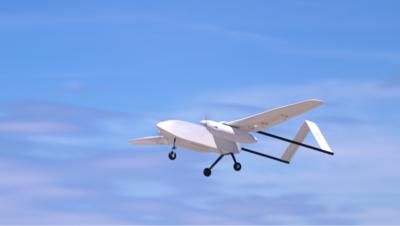Fri, Nov 25, 2022
Self-Contained Hydrogen Engine Nacelle May Be Offered as UAV Aftermarket Modification
H3 Dynamics' twin-engine hydrogen UAV demonstrator completed its first successful test flight over a Paris airfield.

The flight was a capstone of sorts, for a program that first completed a working propulsion nacelle prototype a year prior. By July, H3 Dynamics had been able to test their first distributed pod system on a scale aircraft at the Hub Drones - Systematic airfield near Paris, France. That proved the basic functionality of their hydrogen-powered system, allowing them to begin scaling up their designs. The most recent test evaluated the performance of a twin-engine, hydrogen powered, propeller-driven propulsion aircraft on the way towards larger, more complex installations. While H3 Dynamics will need to continue their progress flying small, uncrewed aircraft, the company eagerly looks to the future, with plans for bigger and better hydrogen aircraft converted from existing makes and models. With the successful demonstration of a twin-engine platform, the company says it will soon tackle a 6-engine aircraft in the same vein.
The uncrewed twin-engine test aircraft boasts a 900 km range on liquid hydrogen, stored entirely in its wing-mounted nacelles. That external mounting allows for safer, less anxiety-inducing carriage of super-flammable hydrogen fuel in addition to maximizing interior cargo storage. Should the demonstrator be powered with pressurized hydrogen, its range drops to 350 km, still quite passable given the aircraft's 30-liter interior volume. H3 Dynamics sees their standalone hydrogen nacelle design as a perfect candidate for aftermarket installation and retrofitment, an easy way to bolster the power of any small aircraft with sustainable, on-demand thrust. The compact size should mean the self-contained hydrogen nacelles can quickly be developed into a snap-on addition to existing eVTOL or fixed wing cargo drones.
“Not only is safety our first priority, but we don’t want hydrogen competing for revenue-generating air freight and passenger space,” said Taras Wankewycz, CEO of H3 Dynamics. As outlined by the company's hydrogen developers, distribution of hydrogen power is key. Spreading the hydrogen propulsion systems allows for more efficient thermal management, increased redundancy, and simpler installation.
H3 Dynamics made mention of their plan to complete an Atlantic crossing on hydrogen-electric hybrid propulsion in the next 2 years, proving the feasibility of liquid h2 power with partner ISAE-SUPAERO.
More News
“These new aircraft strengthen our ability to respond quickly, train effectively and support communities nationwide. Textron Aviation has been a steadfast supporter in helpin>[...]
From 2011 (YouTube Edition): Rugged, Legendary, STOL Twin Makes A Comeback The de Havilland Twin Otter is an airplane with a long history, and it gained a reputation as a workhorse>[...]
A Wind Gust Lifted The Right Wing And The Airplane Turned To The Left Analysis: The pilot was departing from a 2,395-ft-long by 50-ft-wide turf runway. The pilot reported that afte>[...]
Have A Story That NEEDS To Be Featured On Aero-News? Here’s How To Submit A Story To Our Team Some of the greatest new stories ANN has ever covered have been submitted by our>[...]
Braking Action Advisories When tower controllers receive runway braking action reports which include the terms “medium," “poor," or “nil," or whenever weather con>[...]
 Aero-News: Quote of the Day (12.18.25)
Aero-News: Quote of the Day (12.18.25) Classic Aero-TV: Viking Twin Otter 400--Bringing the DHC-6 Back Into Production
Classic Aero-TV: Viking Twin Otter 400--Bringing the DHC-6 Back Into Production NTSB Final Report: Rans Employee Flying Club Rans S-6ES Coyote II
NTSB Final Report: Rans Employee Flying Club Rans S-6ES Coyote II ANN FAQ: Submit a News Story!
ANN FAQ: Submit a News Story! ANN's Daily Aero-Term (12.18.25): Braking Action Advisories
ANN's Daily Aero-Term (12.18.25): Braking Action Advisories



